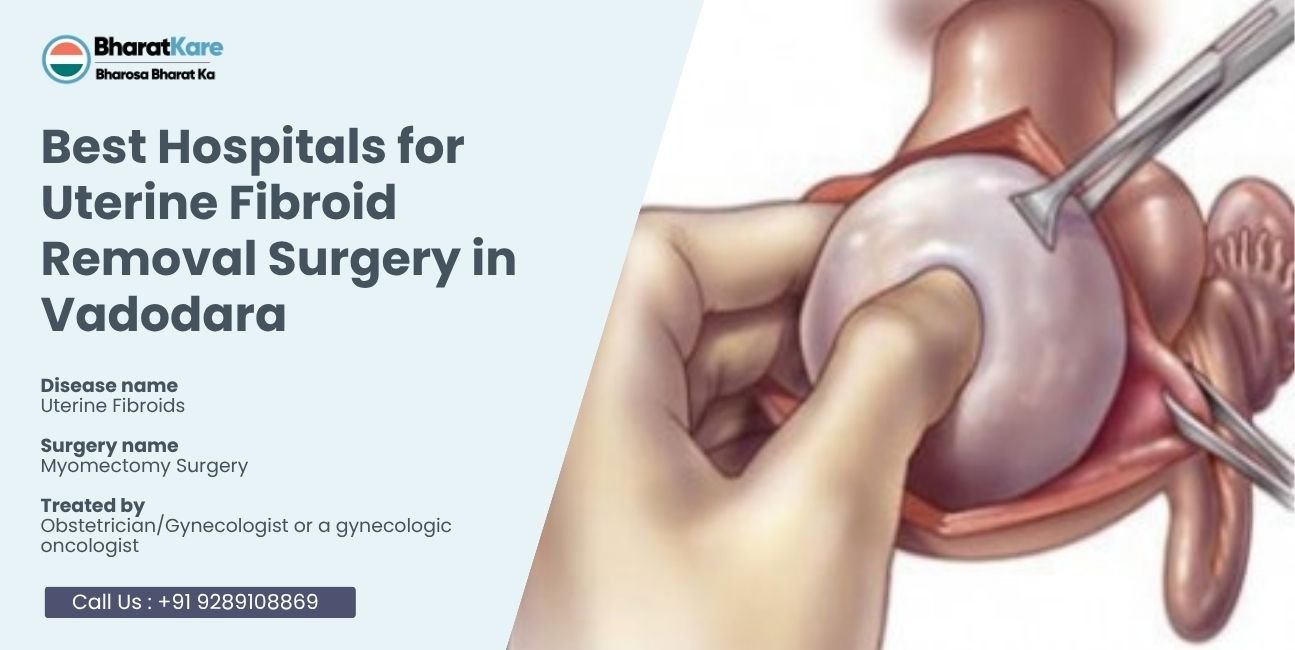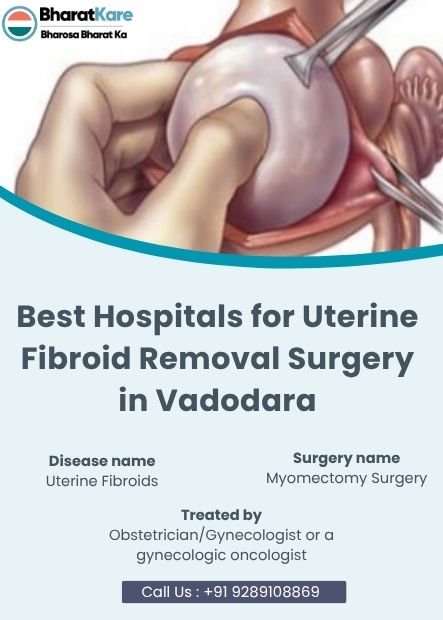Best Hospitals for Uterine Fibroid Removal Surgery in Vadodara
So here’s the thing – I was chatting with my sister-in-law Meera last month, and she’s been having these absolutely horrific periods for like two years now. We’re talking about bleeding through a super tampon and heavy pad in an hour. She finally went to see a doctor who told her she has uterine fibroids the size of ping pong balls. Can you imagine?
She calls me up crying because she’s overwhelmed about where to get fibroid surgery. “I don’t even know where to start looking for good hospitals,” she said. And you know what? I didn’t really know either at first.
But after spending weeks helping her research the best hospitals for uterine fibroid removal surgery in Vadodara (because that’s where she lives), I learned a ton. Like, way more than I ever thought I’d know about fibroid treatment.
Turns out Vadodara has some really solid options. Places like Bharatkare are doing minimally invasive stuff that sounds like science fiction compared to what my mom went through twenty years ago. Back then, they basically had to cut you open from hip to hip. Now? Some women go home the same day.
Anyway, if you’re dealing with this nightmare too, let me save you some time and tell you what I found out.


First, Let’s Figure Out What Kind of Surgery We’re Even Talking About
Honestly, when I first heard all this, my brain just short-circuited. Doctors love tossing out words like “myomectomy” and “hysterectomy” like we’re all supposed to have a medical degree. So, here’s the deal: a myomectomy is basically them going in, yanking out those fibroids, but your uterus gets to stick around. Handy if you’re thinking about having kiddos later, or, you know, just not super into the whole “losing an organ” thing. Hysterectomy? That’s the full send—uterus gone, end of story. Sometimes there’s just no other way, which honestly sucks.
But wait, there’s more options now. Uterine artery embolization – weird name, but basically they block the blood supply to fibroids so they shrivel up. No cutting involved. And laparoscopic fibroid removal where they do everything through tiny holes instead of big cuts.
The thing is, what works for you depends on where your fibroids decided to set up camp. Some women have one giant one, others have like twenty small ones scattered around. Some are hanging off the outside of your uterus, others are buried deep inside the wall.
My friend Priya had three different doctors give her three different recommendations. One wanted to do a full hysterectomy, another said laparoscopic myomectomy would work fine. Super confusing.
The newer minimally invasive techniques are pretty amazing though. Instead of being laid up for two months, some women are back to work in two weeks. That’s a game changer when you’ve got kids to take care of.
What Actually Makes a Hospital Good for This
Here’s what I wish someone had told Meera from the start – bigger doesn’t always mean better when it comes to fibroid surgery.
What you really want is a place where they do tons of these procedures. I’m talking about surgical teams that are removing fibroids multiple times every week, not once in a while. When they’ve done hundreds of these surgeries, they’ve seen every weird thing that can happen.
Equipment matters too, obviously. But it’s not just about having the fanciest robot (though those are pretty cool). It’s about having the right tools for different types of fibroids. Some need laser treatment, others work better with traditional surgical instruments.
The nursing staff ended up being super important for Meera’s recovery. These women know exactly what’s normal and what’s not after fibroid surgery. They can tell the difference between “this is uncomfortable but fine” and “we need to call the doctor right now.”
One thing that really impressed me – good fibroid specialists will spend time explaining what they’re going to do instead of rushing through a consultation. If a doctor makes you feel stupid for asking questions, run.
Also, infection rates. Ask about them. Good hospitals track this stuff and aren’t weird about sharing their numbers. If they won’t tell you, that’s a red flag the size of Texas.
Things I Wish We’d Known Before Starting This Journey
Location ended up being way more important than we thought. Sure, you might be willing to drive two hours for the “best” surgeon, but what happens when you need follow-up care? What if something feels off at midnight on a weekend?
Meera almost made this mistake. She was ready to go to Mumbai because she thought it would automatically be better. Thank god her husband talked her out of it. She ended up needing an urgent follow-up visit four days after surgery, and having her surgeon twenty minutes away instead of four hours away made all the difference.
Insurance stuff is boring but crucial. Some hospitals work great with certain insurance companies, others create paperwork nightmares. Get everything in writing before you schedule anything.
Here’s something nobody tells you – ask about their approach to different types of fibroids. Subserosal fibroids (the ones on the outside), intramural fibroids (stuck in the wall), and submucosal fibroids (hanging into the cavity) all need different techniques. You want doctors who can handle whatever you’ve got.
Recovery support varies wildly between hospitals. Some give you a detailed plan and check in regularly. Others basically say “good luck, call if you’re dying.” Guess which approach works better?
Don’t ignore the discomfort—consult a Best Hospitals for Uterine Fibroid Removal Surgery in Vadodara. Book your appointment today!
The Cool Modern Stuff You Can Get Here
The fibroid treatment options available now are honestly mind-blowing compared to even five years ago.
Robotic surgery sounds terrifying but it’s actually amazing. The surgeon is still doing everything – the robot just makes their hands super steady. Women who’ve had robotic fibroid removal say their scars are practically invisible after a few months.
Laparoscopic fibroid removal has become the gold standard for a lot of cases. Instead of one big incision, they make several tiny ones and remove fibroids with specialized instruments. Recovery is so much faster.
For certain types of fibroids, they can do hysteroscopic myomectomy entirely through your vagina. No external cuts at all. This works especially well for submucosal fibroids that are causing heavy bleeding.
The pain management has gotten incredible too. They use nerve blocks and medication combinations that mean you’re not lying in bed moaning for days. Meera was walking around her house the day after surgery.
Some places are even doing outpatient fibroid surgery now. You go in the morning, have your procedure, and go home that afternoon. Not for everyone, but when it works, it’s pretty convenient.
Your Best Bet Locally
If you’re staying in Vadodara – and honestly, I think that’s usually the smart move – Dr. Ashish Sachdeva at Bharatkare is worth talking to. He’s got twenty years of experience and specifically trained in laparoscopic techniques for gynecological stuff.
What I like about his approach is he doesn’t automatically jump to the biggest surgery. He looks at what’s actually bothering you and tries to fix that with the least invasive method that’ll work. Makes sense, right?
The Bharatkare facility has invested in some seriously good equipment. They’ve got high-definition laparoscopic systems that let surgeons see exactly what they’re doing. Their infection control is solid too, which matters more than you might think.
And honestly, they just get it. Like, they know your life doesn’t pause just because you need surgery—maybe you’ve got kids hanging off you or parents who need you around. They actually think about that when they’re making a plan.
So, Meera picked Dr. Sachdeva in the end (good call, honestly), and it worked out great. Her laparoscopic myomectomy? Super smooth. She bounced back way quicker than she thought she would—almost like she was back to her regular chaos before anyone even noticed she was gone.
Questions You Better Ask During Consultations
Don’t be nice during these consultations. This is your body we’re talking about.
“How many fibroid surgeries do you do every month?” If it’s less than fifteen, keep looking. You want someone who does this stuff regularly.
“What’s your complication rate?” They should know this number without hesitation. If they get defensive or vague, that’s not good.
“Can I talk to someone who’s had this surgery with you recently?” Most good surgeons have former patients who’ll chat with prospective patients. If they can’t arrange this, wonder why.
Ask about pain management specifically. “What will I feel like the first three days?” If they just say “you’ll be fine,” that’s not detailed enough.
“What happens if something goes wrong during surgery?” Not trying to scare you, but complications happen. You want to know they have a plan.
“How many of these procedures have you had to convert from laparoscopic to open surgery?” This tells you how often they have to abandon the minimally invasive approach mid-procedure.
The Money Talk
Let’s be real about costs because fibroid surgery isn’t cheap. Good news is that insurance usually covers it if your fibroids are causing real symptoms.
Different procedures cost different amounts. Laparoscopic surgery might cost more upfront than open surgery, but you’ll probably save money on recovery time and missed work.
Get written estimates from at least two places. Make sure they’re estimating the same procedure. Sometimes one place quotes you for simple myomectomy while another is planning something more complex.
Many hospitals offer payment plans now. Don’t be embarrassed to ask. Medical debt is nothing to mess with, and good hospitals would rather work with you than chase you for money later.
Insurance pre-authorization can take forever, so start early. Having documentation that you tried other treatments first helps with approval.
Recovery – The Part Nobody Prepares You For
The surgery is honestly the easy part. Recovery is where the real work happens.
Different surgical approaches mean totally different recovery timelines. Laparoscopic fibroid removal might mean two weeks of taking it easy. Open surgery could be six to eight weeks before you’re fully back to normal.
Post-surgical bleeding patterns vary a lot. Your surgeon should explain what’s normal for your specific procedure and when to freak out and call them.
Expect to be more tired than you think. Even minimally invasive surgery is still surgery. Your body is working hard to heal.
Some women need physical therapy after extensive fibroid surgery. Ask if this is included in your care plan or if you’ll need separate referrals.
The emotional stuff is real too. Lots of women feel relief that their symptoms are finally being addressed, but some get unexpectedly sad or anxious afterward. Totally normal.
Technology That Actually Helps
Okay, let’s be real—hospitals in Vadodara are finally catching up with some tech stuff, and honestly, it’s made things way smoother for folks dealing with fibroids.
For starters, those new MRI scans? Total game changers. Surgeons can literally zoom in and figure out the exact spot of those pesky fibroids before they even pick up a scalpel. No more guessing games—just straight-up precision.
And then, electronic medical records. Yeah, it sounds boring, but trust me, it’s a lifesaver. No more doctors arguing over a scribbled prescription or nurses trying to decode hieroglyphics on a chart. Everyone’s on the same page, and you’re way less likely to get the wrong meds or mixed-up instructions.
Oh, and get this—some hospitals use 3D imaging now. It’s wild. They’ll actually show you a digital map of your own insides and walk you through what’s about to happen. Super sci-fi, but honestly, it helps calm your nerves when you actually get what’s going on.
Last bit—real-time surgical guidance. Sounds fancy, but it basically means surgeons don’t just go in blind. They get live feedback, so they can zap those fibroids and leave the healthy stuff untouched. Especially clutch if you’re hoping to have kids someday.
Long story short? Tech’s making a huge difference. About time, right?
Don’t ignore the discomfort—consult a Best Hospitals for Uterine Fibroid Removal Surgery in Vadodara. Book your appointment today!
Traditional Surgery vs New Approaches
Sometimes you still need old-school open surgery. If your fibroids are massive or in really tricky spots, there’s no getting around it.
Open myomectomy means a bigger incision and longer recovery, but it allows surgeons to remove multiple large fibroids that might be impossible with other methods. The scar is more visible, but sometimes it’s the only option that makes sense.
Laparoscopic approaches work great for many cases. Smaller incisions, faster recovery, minimal scarring. But there are size and location limits for what they can handle this way.
Robotic surgery combines the benefits of minimally invasive techniques with better precision for complex cases. Costs more, but outcomes are often better for difficult fibroids.
The key is finding surgeons who know multiple techniques and will honestly tell you what’s best for your situation, not just what they prefer doing.
How to Actually Make This Decision
After all this research, how do you actually choose? Meet with two or three surgical teams to get different perspectives.
Pay attention to how they treat you during consultations. Do they listen to your concerns? Explain things clearly? Make you feel rushed or actually heard?
Think about practical stuff too. Which hospital is easiest for follow-up visits? Which works best with your insurance? Which has the services you might need during recovery?
Listen, your gut’s smarter than you think. If you walk into a place or meet a doc and something just… doesn’t vibe? Even if you can’t put your finger on it—bail. You gotta actually trust who’s poking around your insides, ya know?
And dude, don’t just chase the lowest price tag. Sometimes you grab the bargain and end up paying double fixing the mess later. Cheap can get real expensive, real fast.
Real Questions from Real Women
My periods are awful, but I’m managing. Do I really need surgery?
If you’re hanging in there and life’s still rolling along, maybe try a few other options before jumping to anything drastic. But hey, if you’re low on iron from all the blood loss or calling in sick way too often, surgery could actually make sense. Seriously—no need to play the martyr.
I want more kids. Will surgery mess that up?
Well, it really comes down to the type of surgery you’re talking about and where those pesky fibroids decided to set up camp. Myomectomy’s kind of the go-to if you still wanna have kids, but honestly, every body’s different. No one-size-fits-all answer here—seriously, chat with your surgeon and don’t be shy about asking every awkward question that pops into your head.
How long before I can lift my kids again?
This varies based on your procedure and how your kids are. After laparoscopic surgery, maybe two weeks for toddlers. After open surgery, could be six weeks or more. Your doctor will give you specific restrictions.
What if new fibroids grow after surgery?
With myomectomy, new fibroids can develop over time since you still have your uterus. But most women get years of symptom relief. Hysterectomy eliminates the possibility of new fibroids.
I’m terrified of being put under. Any other options?
Most fibroid surgeries require general anesthesia, but it’s much safer now than it used to be. Talk to your anesthesiologist about your fears – they deal with this all the time and can help.
Will insurance definitely pay for this?
Most plans cover medically necessary fibroid treatment, but verify with your insurance company first. Get pre-authorization if your plan requires it. Don’t assume anything.
What should I expect the first week?
You’ll be tired and sore, but shouldn’t have severe pain with good pain management. Most women can walk around the day after surgery, but you’ll need to take it easy. Follow your restrictions exactly.
Bottom Line
Look, dealing with fibroids sucks. Heavy periods that disrupt your life, pelvic pain that makes you miserable – you shouldn’t have to live with this stuff.
The good news is you’ve got solid options right here in Vadodara. You don’t need to travel to Mumbai or Delhi for quality fibroid care. Local places like Bharatkare offer advanced techniques and experienced doctors who understand your needs.
Take time to research, but don’t research forever. Symptomatic fibroids usually get worse over time, not better. The sooner you address them, the more options you’ll have.
Find doctors who listen to you, explain things clearly, and recommend treatments based on your specific situation. Don’t settle for someone who makes you feel rushed or stupid for asking questions.
Remember, successful fibroid treatment isn’t just about removing the growths. It’s about getting back to feeling normal again. You deserve to live without worrying about flooding periods or constant pelvic discomfort.
Your health matters. Quality fibroid care is available here – you just need to know how to find it. Don’t accept anything less than comprehensive, caring treatment for your fibroid problems.
Take charge of this situation. Ask tough questions. Get multiple opinions if you’re unsure. And most importantly, don’t put up with subpar care when excellent options exist.
FAQ
FAQs About Best Hospitals for Uterine Fibroid Removal Surgery in Vadodara: Answering Your Most Common Queries
Vadodara hospitals offer multiple options:
Myomectomy (removes fibroids but keeps the uterus) – Can be done via laparoscopy (minimally invasive), hysteroscopy (for submucosal fibroids), or open surgery (for large/complex cases).
Hysterectomy (removes the uterus) – Recommended only if future pregnancy isn’t desired.
Uterine Artery Embolization (UAE) – Non-surgical, blocks blood supply to shrink fibroids.
Robotic Surgery – High-precision, minimal scarring.
Look for:
High surgical volume (doctors performing fibroid surgeries frequently).
Minimally invasive options (laparoscopic/robotic techniques).
Low infection rates & good post-op care.
Transparent cost & insurance support.
Patient reviews & success rates.
Laparoscopic/Robotic Myomectomy: 1–2 weeks (light work), 4–6 weeks (full recovery).
Open Myomectomy/Hysterectomy: 4–6 weeks (minimum), up to 8 weeks for strenuous activity.
Hysteroscopic Myomectomy: Often just 2–3 days of rest.
UAE (Non-surgical): 1–2 weeks, but may cause temporary pain.
Myomectomy: New fibroids can grow (30–50% chance over 5–10 years).
Hysterectomy: No recurrence (since uterus is removed).
UAE: Fibroids may regrow if blood supply returns.
Most insurance plans cover fibroid removal if medically necessary (heavy bleeding, pain, infertility).
Pre-authorization is required – Submit doctor’s reports confirming symptoms.
Cost varies: Laparoscopic (₹1.5–3 lakhs), Open surgery (₹1–2 lakhs), Hysterectomy (₹2–4 lakhs).
Quick Links
Popular Surgeries
Find Us
© Copyright BharatKare 2025. All Right Reserved.


